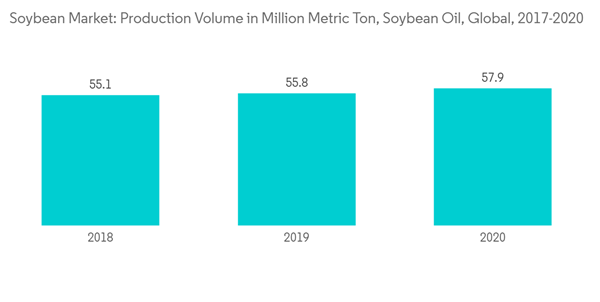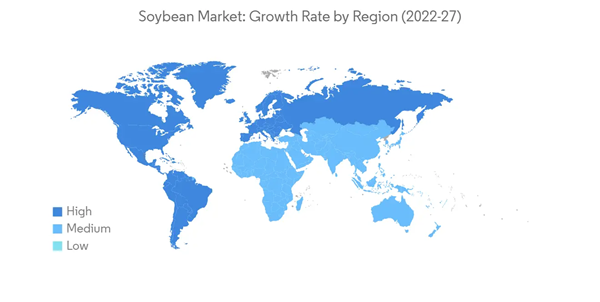The Soybean Market size is estimated at USD 198.12 billion in 2024, and is expected to reach USD 277.88 billion by 2029, growing at a CAGR of 7% during the forecast period (2024-2029).
Along with this, soy lecithin a by-product of soybean is a popular food ingredient because it can be used as a wetting agent, to reduce viscosity and crystallization, to manage cholesterol, and to enhance chlorine. It is a food ingredient with significant applications in dietary supplements, ice creams and dairy products, newborn formulae, bread, margarine, and other convenience foods. Furthermore, soybean meal has a unique composition of amino acids and can be used as an alternative to cereal proteins. Additionally, the demand for high-protein animal feedstuffs like soybean meal increased due to the rise in demand for animal protein in quickly developing nations like China. Because growth rates are outpacing increases in yield per land unit over the long run, there is an increasing demand for soybean production. Therefore, soybean meal is used as feed for animals and for human consumption. The main reasons behind the increasing demand for protein-enriched foods are their health benefits and the growing number of livestock, cattle, ruminants, and other animals in the global market.
Argentina is the world's top soybean oil and meal exporter. For instance, according to the ITC trade map, Argentina exported 6,010,691 million metric ton of soyabean oil in 2021. Additionally, Paraguay is the fourth-largest soybean exporter in the world. According to data from the Paraguayan Chamber of Soybean Exporters the country exports over half of the soybeans it produces, and its economy depends heavily on shipments abroad of raw materials. The enhanced livestock population and the growing demand for soybean meals have improved exports from South American countries in Asia-Pacific and Europe.
This product will be delivered within 2 business days.
Key Highlights
- The production of soybeans kept on increasing in the past few years. The increase in production along with an increase in the area harvested under soybean is likely to drive the market globally. According to FAO, the world soybean production is 336 million metric tons in 2019 increased to 353 million metric ton in 2020. Additionally, soybean can be used for extracting oil, as an edible crop, and as feed for animals. It is frequently used in the culinary business as a salad condiment and for other cooking applications. Soybean is also popular as a low-cholesterol and low-fat food substitute and protein-rich produce. It is an excellent dairy substitute for lactose-intolerant persons. According to the US National Library of Medicine, nearly all humans lose approximately 65% of their ability to digest lactose after infancy. So in such cases, the consumption of soybean helps. The wide usage is driving the soybean market globally.
- The United States, Brazil, Argentina, Canada, Paraguay, and Uruguay are the largest producers and exporters of soybean globally, accounting for more than 85.0% of the global production. For many years, the United States was the world's major producer and exporter of soybean. However, South America became the largest market for soybean production with Brazil being the leading country. According to FAO, in 2020, soybean production increased dramatically in Brazil, attributed to the favorable growing conditions augmented by the soil quality, weather conditions, and water availability. The soybean market is driven by the increasing adoption of veganism in western countries due to the popularity of plant-rich proteins in the diet. The increased health awareness among consumers due to the higher standard of living also impacted the market positively.
Soybean Market Trends
Increased Demand for the Byproducts of Soybean
The demand for soybean by-products like soybean meal and oil cakes increased over the past few years. The high nutritional value of the products enhanced their popularity among consumers, and it is increasing the market. The increased disposable income of consumers in developed countries and the improved soybean productivity in these countries contributed to the demand for soybean byproducts. As per the USDA, in 2020, soybean oil production in the United States was recorded at 11.3 million metric ton, increasing from 10.8 million metric ton in 2018. The demand for soybean oil in the country contributed to the production of commodities, which is anticipated to drive the market during the forecast period.Along with this, soy lecithin a by-product of soybean is a popular food ingredient because it can be used as a wetting agent, to reduce viscosity and crystallization, to manage cholesterol, and to enhance chlorine. It is a food ingredient with significant applications in dietary supplements, ice creams and dairy products, newborn formulae, bread, margarine, and other convenience foods. Furthermore, soybean meal has a unique composition of amino acids and can be used as an alternative to cereal proteins. Additionally, the demand for high-protein animal feedstuffs like soybean meal increased due to the rise in demand for animal protein in quickly developing nations like China. Because growth rates are outpacing increases in yield per land unit over the long run, there is an increasing demand for soybean production. Therefore, soybean meal is used as feed for animals and for human consumption. The main reasons behind the increasing demand for protein-enriched foods are their health benefits and the growing number of livestock, cattle, ruminants, and other animals in the global market.
South America Dominates the Global Export Market
South America is the largest exporter in the global market for soybeans. Brazil, Argentina, and Paraguay account for more than 50% of the world's soybean supply. In South America, Brazil was the largest exporter of soybeans in 2020, accounting for 44.4% of total global exports, followed by Argentina and Paraguay. The soybean production in Brazil accounted for 114.7 million metric ton in 2017, increasing to 121.7 million metric ton in 2020. This increase in production is boosting soybean exports in the coming years. The low value of the Brazilian currency in 2020 made the price of soybeans competitive in the international market. The increased awareness among farmers about soybean cultivation and the well-equipped nature of cultivation in the region enhanced soybean production. The domestic and global demand for oilseeds like soybean has been rising over the years, impacting the prices of soybean and farmers' revenue positively. The US-China trade war contributed to the growing exports from Brazil to China.Argentina is the world's top soybean oil and meal exporter. For instance, according to the ITC trade map, Argentina exported 6,010,691 million metric ton of soyabean oil in 2021. Additionally, Paraguay is the fourth-largest soybean exporter in the world. According to data from the Paraguayan Chamber of Soybean Exporters the country exports over half of the soybeans it produces, and its economy depends heavily on shipments abroad of raw materials. The enhanced livestock population and the growing demand for soybean meals have improved exports from South American countries in Asia-Pacific and Europe.
Soybean Industry Overview
Additional Benefits:
- The market estimate (ME) sheet in Excel format
- 3 months of analyst support
This product will be delivered within 2 business days.
Table of Contents
1 INTRODUCTION
4 MARKET DYNAMICS
5 MARKET SEGMENTATION (Production Analysis, Consumption Analysis by Value and Volume, Import Analysis by Value and Volume, Export Analysis by Value and Volume and Price Trend)
Methodology

LOADING...










